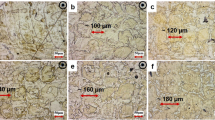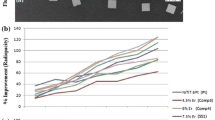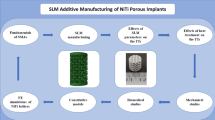Abstract
With the drive towards minimally invasive procedures, the medical industry is looking towards ‘avant-garde’ materials, with 50NiTi currently being the prime choice for many critical components/applications. This paper examines a new Ni-rich NiTi alloy that exhibits superelasticity (SE) and shape memory (SM) properties. Superelastic (SE) properties of 55NiTi* [all compositions are quoted in atomic% throughout the paper. The reader should note the following conversions: 50NiTi (at.%)≈55NiTi (wt.%) and 55NiTi (at.%)≈60NiTi (wt.%)] are studied here as a function of heat-treatment between 400–800°C, and compared with the corresponding response of 50NiTi*, with an aim to develop and optimize thermal treatment procedures to maximize recoverable elastic strains. While optimal tuning of the SE properties in 50NiTi necessitates cold working in conjunction with specific heat treatment/aging, 55NiTi does not require cold work to achieve its optimal SE behavior. Moreover, it can be heat treated to produce strong, stable SE and SM response from the same ingot, with transformation temperatures being a strong function of heat treatment. The main difference between the two alloys is that Ni–Ti alloys with Ni content greater than 50.6 at.% are sensitive to heat treatment; aging in these materials leads to precipitation of several metastable phases. The initial work focuses on SE properties relevant to biomedical use, such as: plateau stress, recoverable strains and strength, as a function of heat treatment and microstructure.







Similar content being viewed by others
References
Duerig T, Pelton A, Stockel D (1999) An overview of Nitinol medical applications. Mater Sci Eng A 273–275:149–160.
Pelton AR, DiCello J, Miyazaki S (2000) Optimization of processing and properties of medical grade Nitinol wire. Minim Invasive Ther Allied Technol 9(1):107–118.
Stockel D (2000) Nitinol medical devices and implants. Journal of the Society for Minimally Invasive Therapy and Allied Technology (MITAT) 9(2):81.
Frank TG, Xu W, Cuschieri A (2000) Instruments based on shape memory alloy properties for minimal access surgery, interventional radiology and flexible endoscopy. Journal of Minimally Invasive Therapy and Allied Technologies (MITAT) 9(2):89–98.
Tang W (1997) Thermodynamic study of the low temperature phase B19’ and the martensitic transformation in near-equiatomic Ti–Ni shape memory alloy. Metall Trans A 28:537–544.
Otsuka K, Ren X (2005) Physical metallurgy of Ti–Ni based shape memory alloys. Prog Mater Sci 50:511–678.
Otsuka K, Wayman CM (eds) (1998) Shape memory materials. Cambridge University Press, Cambridge, UK. 284.
Miyazaki S, Ohmi Y, Otsuka K, Suzuki Y (1982) Characteristics of deformation and transformation pseudoelasticity in titanium–nickel alloys. J Phys Colloq (C-4):255–260.
Nishida M, Wayman CM, Honma T (1986) Precipitation processes in near-equiatomic TiNi shape memory alloys. Metall Trans A 17:1505–1515.
Miyazaki S, Imai T, Igo Y, Otsuka K (1986) Effect of cyclic deformation on the pseudoelasticity characteristics of titanium–nickel alloys. Metall Trans A 17(1):115–120.
Buehler WJ, Wiley RC (1961) The properties of TiNi and associated phases. Report NOLTR 61–75 (AD 266607). U. S. Naval Ordnance Laboratory, White Oak, Silver Spring MD.
Jackson CM, Wagner HJ, Wasilewski RJ (1972) 55-Nitinol—The alloy with a memory: Its physical metallurgy, properties, and applications. National Aeronautics and Space Administration-SP5110: Washington, D. C.
60-Nitinol Alloys Data Sheet, U. S. Naval Ordnance Laboratory: White Oak, MD.
Clingman DJ, Clalkins FT, Smith JP (2003) Thermomechanical properties of Ni(60%wt)Ti(40%wt). Proceedings of SPIE—The international society for optical engineering, 5053 (Active Materials: Behavior and Mechanics), p 219–229.
Julien GJ (2002) Manufacturing of Nitinol parts and forms, U. S. Patent 6422010.
Mabe JH, Ruggeri RT, Rosenzweig E, Yu C-JM (2004) Nitinol performance characterization and rotary actuator design. Proceedings of SPIE—The international society for optical engineering 5388 (Industrial and Commercial Applications of Smart Structures Technologies), p 95–109.
Robertson SW, Gong XY, Ritchie RO (2006) Effect of product form and heat treatment on the crystallographic texture of austenitic Nitinol. J Mater Sci 41:621–630.
Kainuma R, Matsumoto M, Honma T (1987) Metallographic study of precipitation processes in Ni-rich TiNi alloys. Tohoku Daigaku Senko Seiren Kenkyujo iho 43(2):149–158.
Gall K, Sehitoglu H, Chumlyakov YI, Kireeva IV (1999) Pseudoelastic cyclic stress-strain response of over-aged single crystal Ti-50.8at.%Ni. Scr Mater 40(1):7–12.
Gall K, Sehitoglu H, Chumlyakov YI, Zuev YL, Karaman I (1998) The role of coherent precipitates in martensitic transformation in single crystal and polycrystalline Ti-50.8at.%Ni. Scr Mater 39(6):699–705.
Gall K, Maier HJ (2002) Cyclic deformation mechanisms in precipitated NiTi shape memory alloys. Acta Mater 50:4463–4657.
Orgeas L, Favier D (1995) Non-symmetric tension-compression behavior of NiTi alloy. Journal de Physique IV, 5(C8, International conference on martensitic transformations, Pt. 2), p 605–10.
Plietsch R, Ehrlich K (1997) Strength differential effect in pseudoelastic NiTi shape memory alloys. Acta Mater 45(6):2417–2424.
Gall K, Sehitoglu H, Chumlyakov YI, Kireeva IV (1999) Tension-compression asymmetry of the stress-strain response in aged single crystal and polycrystalline NiTi. Acta Mater 47:1203–1217.
Gall K, Sehitoglu H (1999) The role of texture in tension-compression asymmetry in polycrystalline NiTi. Int J Plast 15(1):69–92.
Sittner P, Novak V, Lukas P, Lugovyy D, Neov D, Tovar M (2002) Load partition in NiTi shape memory alloy polycrystals investigated by in-situ neutron diffraction and micromechanics modelling. Materials Science Forum. 404–407(ECRS 6, Proceedings of the 6th European conference on residual stresses, 2002), p. 829–834.
Adharapurapu RR, Jiang F, Vecchio KS, Gray GT III (2006) Response of NiTi shape memory alloy at high strain rate: A systematic investigation of temperature effects on tension-compression asymmetry. Acta Materialia 54:4609–4620.
Miyazaki S, Kohiyama Y, Otsuka K, Duerig TW (1990) Effects of several factors on the ductility of the Ti–Ni alloy. Mat Sci Forum 56–58:765–770.
Acknowledgments
This work was funded under contract from the US Army, Picatinny Arsenal, with Dr. Sheldon Cytron as contract monitor and technical advisor.
Author information
Authors and Affiliations
Corresponding author
Additional information
1All compositions are quoted in atomic% throughout the paper. The reader should note the following conversions: 50NiTi (at.%) ≈ 55NiTi (wt.%) and 55NiTi (at.%) ≈ 60NiTi (wt.%)
Rights and permissions
About this article
Cite this article
Adharapurapu, R.R., Vecchio, K.S. Superelasticity in a New BioImplant Material: Ni-rich 55NiTi Alloy. Exp Mech 47, 365–371 (2007). https://doi.org/10.1007/s11340-006-9004-x
Received:
Accepted:
Published:
Issue Date:
DOI: https://doi.org/10.1007/s11340-006-9004-x




